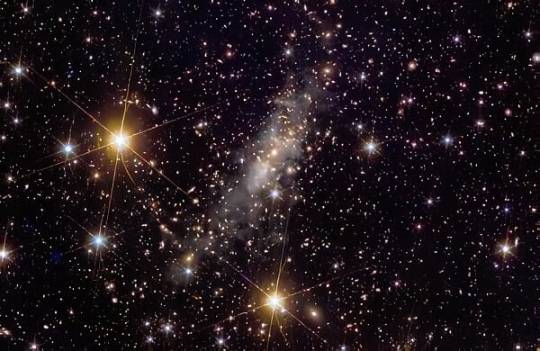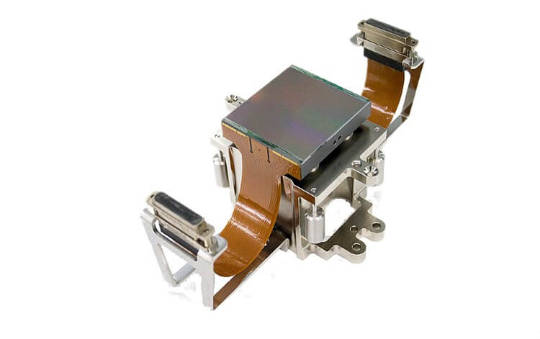#PerseusCluster
Explore tagged Tumblr posts
Text
Discovery Alert! In a new image released from Euclid Telescope, 1000s of new galaxies found in Perseus Cluster. Full article here

Prepare to be captivated by the latest celestial revelation! 🚀 Euclid Telescope's lens has unveiled a mesmerizing snapshot of the Perseus Cluster of galaxies, and it's nothing short of a cosmic masterpiece.
🔭 In this breathtaking image, thousands of galaxies adorn the boundless expanse of space, with the nearest belonging to the Perseus Cluster. These prominent members of the cluster are like glowing streetlamps on a misty night, surrounded by enchanting halos. Meanwhile, the backdrop features over a hundred thousand more galaxies, each with their unique shapes and a vibrant spectrum of colors.
🌟 The most distant galaxies appear as tiny points of light, growing redder as they journey deeper into the universe. This discovery not only showcases the sheer beauty of the cosmos but also provides invaluable insights into dark matter, galaxy distribution, and the cosmic web.
🔍 Dive into the full article to explore the wonders of this cosmic revelation and how it's reshaping our understanding of the universe. 🌠🪐
#CosmicDiscovery #EuclidTelescope #PerseusCluster #AstronomyWonders #SpaceExploration
4 notes
·
View notes
Text
Euclid Spacecraft Reveals Dark Universe

A treasure trove of data from the Euclid spacecraft, including significant contributions from UK scientists, has unveiled the largest images of the Universe ever captured from space. The release marks a milestone in the quest to understand dark matter and dark energy.
Unveiling the Dark Universe
A significant breakthrough in space exploration has emerged from the European Space Agency's Euclid mission. Launched in July 2023, the mission aims to map the ‘dark Universe’ by observing two billion galaxies to create a comprehensive 3D map. UK scientists have played a pivotal role in this mission, contributing to the release of the largest space images ever taken.
The Significance of the Euclid Mission
The Euclid mission is dedicated to uncovering the mysteries of dark matter and dark energy, which comprise most of the Universe but remain poorly understood. The data released, stemming from only 24 hours of observations, offers a glimpse into the immense potential of Euclid in studying the cosmos. Dr. Caroline Harper, Head of Space Science at the UK Space Agency, emphasized the mission's importance: "A key part of our purpose as a space agency is to understand more about the Universe, what it’s made of and how it works. The Euclid mission epitomizes this quest." Contributions from UK Scientists UK scientists have been integral to the Euclid mission, contributing significantly to its early results. Among the notable contributions is a paper by Professor Mark Cropper from UCL Mullard Space Science Laboratory. Over 16 years, he led the development of the VIS optical camera, one of the largest ever sent into space, supported by £20 million of UK Space Agency funding. Professor Mark Cropper remarked: "These are the largest images of the Universe ever taken from space, covering large swathes of the sky in fine detail. They demonstrate Euclid’s wide-ranging potential."
Exploring the Perseus Cluster
Another groundbreaking paper from Professor Nina Hatch at the University of Nottingham examines the Perseus Cluster, a group of galaxies 240 million light-years away. This cluster is crucial for understanding dark matter, as its formation relies on the presence of this elusive substance. Professor Nina Hatch highlighted a surprising discovery: "Euclid’s images of the Perseus Cluster revealed a faint glow between the galaxies, known as intracluster light. This light can help us map dark matter if we understand where the intracluster stars came from." Technological Marvel: The VIS Optical Camera The VIS optical camera is a technological marvel, requiring exquisite precision and stability to achieve Euclid's core aims. The UK’s contribution to this instrument underscores its commitment to pioneering space science. Feature Description VIS Optical Camera One of the largest cameras sent to space, developed over 16 years UK Space Agency Funding Supported by £20 million of funding Key Applications Discovering new planets, studying dark matter, mapping galaxy clusters Technological Specifications Requires high stability and precise conditions Imaging Capability Produces largest images of the Universe ever taken from space The Role of the UK in Data Processing The UK’s involvement extends beyond instrument development. It plays a significant role in the Euclid Science Ground Segment, processing data from the telescope into science-ready products. A consortium of UK universities, led by the University of Edinburgh, provides critical data processing pipelines. Professor Andy Taylor from the University of Edinburgh noted: "These new images from Euclid are stunning. They demonstrate both the image quality and the huge area of the sky seen by Euclid in each observation."

Teledyne e2v, based in Chelmsford, provided the telescope’s Charged Couple Device detectors. Photo by Teledyne e2v. Gov.uk. Industrial Contributions and International Collaboration Teledyne e2v, based in Chelmsford, provided the telescope’s Charged Couple Device detectors, crucial for capturing high-resolution images. This collaboration highlights the synergy between industry and academia in advancing space science. Antonio Spatola, Director of Business Development and Sales at Teledyne e2v, expressed pride in their contribution: "We are privileged to contribute enabling technology to this important science mission." A Step Forward in Cosmic Understanding The Euclid mission represents a remarkable achievement in space exploration and a significant step forward in our understanding of the dark Universe. UK scientists and institutions have demonstrated excellence in contributing to this mission, showcasing the nation's leadership in space science and technology. As the Euclid mission continues, the data and images it provides will be instrumental in answering fundamental questions about the Universe's composition and evolution. The collaboration and dedication of scientists and engineers across the globe underscore the importance of international efforts in uncovering the secrets of the cosmos. Sources: THX News & UK Space Agency. Read the full article
#cosmichistory#darkenergy#darkmatter#darkUniverse#Euclidmission#galaxyclusters#PerseusCluster#spacetelescope#UKscientists#thxnews
0 notes
Text
#Spacialize
On April 18th, 2025, "#JamesWebb #SpaceTelescope detected something no one expected — a symmetrical, time-inverted signal pulsing from deep within the #PerseusCluster...How the #signal changed after a #quantum #AI reply was sent"
#astrophysics
https://youtu.be/JCtce3NYD8U?si=tPlyC5wFYeVSlJ69
0 notes
Text
Over bananen, bulbulons, donkere materie en de mysterieuze 3,5 KeV emissielijn
De emissielijn, waargenomen met de Metal Oxide Semi-conductor CCD camera van XMM-Newton
Ik heb dit jaar al menig keer geblogd1 over de mysterieuze emissielijn die sterrenkundigen bij een energie van 3,5 kilo electronvolt (keV) in het röntgengedeelte van het spectrum van talloze clusters van sterrenstelsels hebben ontdekt, onder andere in de Perseus cluster én in het nabije sterrenstelsel M31, en die niet verklaard kan worden door de overgang van welke bekende atoom dan ook. Vele sterrenkundigen denken daarom dat de bulbulon-lijn, zoals ze ‘m ook wel noemen, alleen verklaard kan worden door de annihilatie van deeltjes donkere materie, met name steriele neutrino’s, maar anderen zijn de mening toegedaan dat de sterrenkundigen die dat denken helemaal ‘going bananas‘ zijn en de 3,5 KeV lijn verklaard kan worden door de atoomovergang van kalium en chloor – die term going bananas komt van dit vakartikel. De wetenschappers lagen duidelijk in de clinch met elkaar, eigenlijk nog steeds, en natuurkundige en blogger Jester (a.k.a. Adam Falkowski) vat dat als volgt samen:
Sinds die publicaties met nogal uiteenlopende meningen zijn we drie maanden verder gekomen en in die tijd is er wel een en ander gebeurd:
diverse groepen zijn aan de slag gegaan om de 3,5 KeV ook te vinden in de straling van clusters van sterrenstelsels en ze hebben niets gevonden (in de blog van Jester vind je diverse links naar die studies.)
Over de waargenomen lijn in M31 (het Andromedastelsel) verschillen de meningen, sommigen zien de lijn daar niet, anderen weer wel. Ook hier weer: zie Jester voor de links naar die studies.
Over de interpretatie van alle waarnemingen wordt nog steeds flink ‘gedebatteerd’, met aan de ene kant de Bulbulon-groep van Esra Bulbul et al, die een signaal van steriele neutrino’s herkennen in het signaal, en aan de andere kant de Bananen-groep van Tesla E. Jeltema en Stefano Profumo, die nog steeds van mening zijn dat de lijn door het verval van kalium kan worden verklaard. Hieronder een afbeelding over steriele neutrino´s, een hypothetische zwaardere variant van de bekende neutrino´s.
Over die chloor-verklaring zijn beide kampen het inmiddels eens geworden: de Cl-XVII Lyman-β overgang van chloor kan géén verklaring zijn voor de 3,5 KeV lijn, dus daarin lijkt de Bulbulon-groep gewonnen te hebben.
Samenvattend denkt Jester dat het op dit moment een stuk onwaarschijnlijker is dat steriele neutrino’s, een vorm van donkere materie, inderdaad de verklaring zijn voor de 3,5 KeV lijn. Meer gegevens zijn nodig om een definitief oordeel te vellen. Wordt vervolgd. Bron: Résonaances + Quantum Diaries.
Noot:
Startend met deze in februari. [↩]
Astroblogs: http://www.astroblogs.nl/2014/11/22/bananen-bulbulons-donkere-materie-en-de-mysterieuze-35-kev-emissielijn/
0 notes